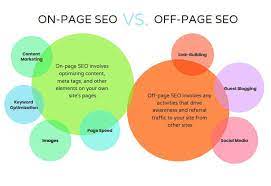On-Page Optimization: Enhancing Your Website’s Visibility and Performance
In the world of digital marketing, on-page optimization plays a crucial role in improving a website’s visibility, search engine rankings, and overall performance. It involves optimizing various elements within a webpage to make it more search engine-friendly and user-friendly. By implementing effective on-page optimization techniques, businesses can attract more organic traffic, enhance user experience, and ultimately achieve their online marketing goals.
One of the key aspects of on-page optimization is keyword research and implementation. Thorough keyword research helps identify the most relevant and high-performing keywords for your website. These keywords should be strategically placed in page titles, meta descriptions, headings, and throughout the content to signal search engines about the page’s relevance to specific search queries. However, it is important to use keywords naturally and avoid overstuffing them, as this can negatively impact user experience.
Another critical factor in on-page optimization is creating compelling and informative content. High-quality content that addresses users’ needs not only engages visitors but also encourages them to spend more time on your website. Search engines value well-written content that provides value to users. Incorporating relevant keywords into your content while maintaining its readability is essential for both search engine crawlers and human readers.
Optimizing your website’s loading speed is also vital for on-page optimization. Users expect websites to load quickly, and search engines take loading speed into account when ranking websites. Compressing images, minifying code, leveraging browser caching, and reducing unnecessary scripts are some techniques that can significantly improve your website’s loading time.
Properly structuring your content using headings (H1-H6 tags) helps both users and search engines understand the hierarchy of information on a webpage. Clear headings make it easier for visitors to navigate through your content while signaling important sections to search engines.
Furthermore, optimizing meta tags such as title tags and meta descriptions is crucial for increasing click-through rates from search engine result pages (SERPs). Well-crafted and compelling meta tags can entice users to click on your website’s link, leading to increased organic traffic.
Mobile optimization is another critical aspect of on-page optimization. With the majority of internet users accessing websites through mobile devices, it is essential to ensure that your website is responsive and provides a seamless user experience across different screen sizes. Mobile-friendly websites not only improve user satisfaction but also receive preferential treatment from search engines.
Lastly, optimizing URLs by making them concise, descriptive, and keyword-rich can enhance both user experience and search engine visibility. Clear URLs that accurately reflect the content of a webpage are more likely to be clicked on by users and understood by search engines.
In conclusion, on-page optimization is an integral part of any successful digital marketing strategy. By implementing effective techniques such as keyword research, content creation, page speed optimization, proper heading structure, meta tag optimization, mobile optimization, and URL optimization, businesses can improve their website’s visibility in search engine results and provide a better user experience. Embracing on-page optimization practices will ultimately lead to increased organic traffic, higher rankings, and improved online performance for your website.
5 Frequently Asked Questions about On-Page Optimization: Explained
- What is a on-page optimization?
- What is on-page optimization as an SEO strategy?
- Why on-page optimization is important?
- What are on-page and off-page optimization?
- How do you do on-page SEO optimization?
What is a on-page optimization?
On-page optimization refers to the practice of optimizing various elements within a webpage to improve its visibility, search engine rankings, and overall performance. It involves making strategic changes to the content, HTML source code, and structure of a webpage to make it more search engine-friendly and user-friendly.
The goal of on-page optimization is to signal search engines about the relevance and value of a webpage in relation to specific search queries. By implementing effective on-page optimization techniques, businesses can increase their chances of ranking higher in search engine result pages (SERPs) and attract more organic traffic.
Some key aspects of on-page optimization include:
- Keyword Research: Identifying relevant keywords that users are likely to search for when looking for information related to your website’s content. These keywords are strategically incorporated into various elements of the webpage.
- Content Optimization: Creating high-quality, informative, and engaging content that addresses users’ needs. This involves incorporating relevant keywords naturally into the content while maintaining readability.
- Meta Tags Optimization: Optimizing meta tags such as title tags and meta descriptions to accurately describe the content of the webpage. Well-crafted meta tags can entice users to click on your website’s link in SERPs.
- Heading Structure: Properly structuring content using headings (H1-H6 tags) helps both users and search engines understand the hierarchy and organization of information on a webpage.
- Page Speed Optimization: Optimizing website loading speed by compressing images, minifying code, leveraging browser caching, and reducing unnecessary scripts. Faster loading times enhance user experience and can positively impact search engine rankings.
- Mobile Optimization: Ensuring that your website is responsive and provides a seamless user experience across different screen sizes. Mobile-friendly websites receive preferential treatment from search engines due to the increasing number of mobile internet users.
- URL Optimization: Creating concise, descriptive, and keyword-rich URLs that accurately reflect the content of a webpage. Clear URLs improve user experience and can be more easily understood by search engines.
By implementing these on-page optimization techniques, businesses can improve their website’s visibility, increase organic traffic, enhance user experience, and ultimately achieve their online marketing goals. On-page optimization is an essential component of a comprehensive digital marketing strategy.
What is on-page optimization as an SEO strategy?
On-page optimization, as an SEO strategy, refers to the practice of optimizing various elements within a webpage to improve its visibility and relevance in search engine rankings. It involves making changes directly on the website itself, focusing on factors that are within your control.
The goal of on-page optimization is to align your webpages with the search engine’s algorithms and user expectations. By implementing effective on-page optimization techniques, you can increase the chances of your website ranking higher in search engine results pages (SERPs) and attract more organic traffic.
Some key elements of on-page optimization include:
- Keyword Research and Implementation: Conducting thorough keyword research to identify relevant keywords for your content. These keywords should be strategically placed in page titles, meta descriptions, headings, and throughout the content.
- Content Optimization: Creating high-quality, informative, and engaging content that addresses users’ needs. Incorporating relevant keywords naturally within the content while maintaining readability is important.
- Meta Tags Optimization: Optimizing meta tags such as title tags and meta descriptions to accurately describe the webpage’s content and entice users to click through from SERPs.
- URL Optimization: Creating concise, descriptive, and keyword-rich URLs that accurately reflect the content of a webpage.
- Heading Structure: Properly structuring content using headings (H1-H6 tags) to help both users and search engines understand the hierarchy of information on a webpage.
- Image Optimization: Optimizing images by compressing them without compromising quality, using descriptive alt tags, and ensuring proper file names.
- Internal Linking: Establishing logical internal linking between related pages on your website to improve navigation and distribute link authority.
- Page Speed Optimization: Enhancing website loading speed by compressing images, minifying code, leveraging browser caching, and reducing unnecessary scripts.
- Mobile Optimization: Ensuring that your website is responsive and provides a seamless user experience across different screen sizes, as mobile-friendliness is a ranking factor.
- User Experience: Creating a user-friendly website with intuitive navigation, clear calls-to-action, and easy-to-read content that encourages visitors to stay longer and engage with your site.
By implementing these on-page optimization strategies, you can improve your website’s visibility, relevance, and overall performance in search engine rankings. It is important to note that on-page optimization works in conjunction with off-page optimization strategies like link building to achieve comprehensive SEO success.
Why on-page optimization is important?
On-page optimization is important for several reasons:
- Improved Search Engine Visibility: Search engines rely on various factors to determine the relevance and quality of a webpage. By implementing on-page optimization techniques, you can provide search engines with clear signals about your webpage’s content, making it easier for them to understand and index your website. This, in turn, enhances your website’s visibility in search engine result pages (SERPs) and increases the likelihood of attracting organic traffic.
- Higher Search Engine Rankings: On-page optimization helps improve your website’s rankings in search engine results. When search engines recognize that your webpage is optimized with relevant keywords, well-structured content, and other on-page elements, they are more likely to rank it higher for relevant search queries. Higher rankings lead to increased visibility and exposure to potential customers.
- Enhanced User Experience: On-page optimization techniques contribute to improving user experience on your website. By creating high-quality content, optimizing page loading speed, ensuring mobile responsiveness, and organizing information with clear headings, you provide visitors with a seamless and enjoyable browsing experience. When users find value in your website and have a positive experience navigating through it, they are more likely to stay longer, engage with your content, and potentially convert into customers.
- Targeted Traffic Generation: Effective on-page optimization allows you to target specific keywords or topics relevant to your business or industry. By aligning your content with users’ search intent through keyword research and implementation, you can attract highly targeted traffic that is more likely to convert into leads or sales. This targeted traffic increases the chances of reaching the right audience who are actively searching for products or services related to what you offer.
- Competitive Advantage: In today’s competitive digital landscape, on-page optimization gives you an edge over competitors who may not be utilizing these techniques effectively. By optimizing various on-page elements such as meta tags, headings, URLs, and content structure better than your competitors, you can stand out in search results and attract more attention from potential customers.
- Long-Term Benefits: On-page optimization provides long-term benefits for your website’s visibility and performance. Once you have implemented effective optimization techniques, they continue to work for you over time. As search engines crawl and index your website, they recognize the relevance and quality of your content, leading to sustained visibility and improved rankings.
In summary, on-page optimization is crucial for improving search engine visibility, achieving higher rankings, enhancing user experience, generating targeted traffic, gaining a competitive advantage, and securing long-term benefits for your website. By investing time and effort into optimizing your webpages effectively, you can reap the rewards of increased organic traffic, improved online presence, and ultimately greater business success.
What are on-page and off-page optimization?
On-page optimization and off-page optimization are two essential components of search engine optimization (SEO) that work together to improve a website’s visibility, rankings, and overall performance in search engine results pages (SERPs).
On-Page Optimization:
On-page optimization refers to the practices and techniques implemented directly on a website’s individual pages to enhance its search engine friendliness and user experience. It involves optimizing various elements within a webpage to make it more relevant, informative, and accessible to both search engines and users. Some key aspects of on-page optimization include:
Keyword research and implementation: Identifying relevant keywords and strategically incorporating them into page titles, meta descriptions, headings, content, alt tags for images, and URLs.
Content creation: Developing high-quality, informative, and engaging content that addresses users’ needs while incorporating relevant keywords naturally.
HTML tags: Properly structuring HTML tags such as heading tags (H1-H6), title tags, meta descriptions, alt attributes for images, and internal linking to facilitate better understanding by search engines.
Page speed optimization: Optimizing the website’s loading speed by compressing images, minifying code, leveraging browser caching, reducing unnecessary scripts or plugins to ensure fast loading times.
Mobile optimization: Ensuring that the website is responsive and provides a seamless user experience across different devices and screen sizes.
URL optimization: Creating concise, descriptive URLs that accurately reflect the content of each webpage.
Off-Page Optimization:
Off-page optimization refers to activities conducted outside of a website with the aim of improving its visibility and authority in search engine rankings. Unlike on-page optimization which focuses on optimizing individual webpages internally, off-page optimization involves external factors that influence a website’s reputation and credibility in the eyes of search engines. Some key aspects of off-page optimization include:
Link building: Acquiring high-quality backlinks from reputable websites through strategies like guest blogging, influencer outreach, social bookmarking, and directory submissions. Backlinks act as “votes of confidence” for search engines, indicating the website’s credibility and authority.
Social media marketing: Utilizing social media platforms to promote content, engage with the audience, and build brand awareness. Social signals such as likes, shares, and comments can indirectly impact search engine rankings.
Online reputation management: Monitoring and managing online reviews, ratings, and mentions to maintain a positive online reputation.
Brand mentions: Encouraging others to mention your brand or website in their content without necessarily linking back to it. These mentions can contribute to brand visibility and authority.
Influencer marketing: Collaborating with influential individuals or industry experts to endorse your brand or content, which can lead to increased visibility and credibility.
Both on-page optimization and off-page optimization are crucial for a comprehensive SEO strategy. While on-page optimization ensures that a website is technically optimized for search engines and provides a positive user experience, off-page optimization focuses on building the website’s reputation and authority through external factors. By combining these two approaches effectively, businesses can improve their website’s visibility in search engine results pages (SERPs) and drive organic traffic to their site.
How do you do on-page SEO optimization?
On-page SEO optimization involves various techniques and practices to improve the visibility and performance of a webpage. Here are some key steps to follow when implementing on-page SEO:
- Keyword Research: Conduct thorough keyword research to identify relevant and high-performing keywords related to your webpage’s content. Use keyword research tools to find popular search terms and incorporate them strategically throughout your content.
- Title Tag Optimization: Craft a compelling and descriptive title tag that includes your target keyword. Keep it within the recommended character limit (around 50-60 characters) and ensure it accurately represents the content of the page.
- Meta Description Optimization: Write an engaging meta description that summarizes the page’s content and entices users to click through from search engine result pages (SERPs). Include relevant keywords naturally, but avoid keyword stuffing.
- Heading Tags: Utilize heading tags (H1, H2, H3, etc.) to structure your content hierarchically. The H1 tag should contain the main heading or title of the page, while subsequent headings should be used to divide sections and subtopics.
- Content Optimization: Create high-quality, informative, and engaging content that addresses users’ needs. Incorporate relevant keywords throughout the content naturally, without overstuffing them. Use variations of keywords where appropriate.
- URL Structure: Optimize your URLs by making them concise, descriptive, and keyword-rich. Avoid using long strings of numbers or irrelevant characters in URLs. A clean URL structure helps both users and search engines understand the topic of a webpage.
- Image Optimization: Compress images to reduce file size without compromising quality, as large image files can slow down page loading speed. Add descriptive alt tags to images for better accessibility and search engine understanding.
- Internal Linking: Include internal links within your content to connect relevant pages on your website. This helps search engines discover other pages on your site while improving user navigation and engagement.
- Page Speed Optimization: Optimize your webpage’s loading speed by compressing images, minifying code, leveraging browser caching, and reducing unnecessary scripts. A faster-loading website improves user experience and search engine rankings.
- Mobile Optimization: Ensure your website is responsive and mobile-friendly. With the majority of users accessing the internet through mobile devices, optimizing for mobile is crucial for both user experience and search engine visibility.
- Schema Markup: Implement schema markup to provide additional context to search engines about your content. Schema markup helps search engines understand the type of content on a webpage, leading to enhanced visibility in SERPs.
- User Experience (UX): Focus on providing a seamless and intuitive user experience throughout your website. Easy navigation, clear calls-to-action, fast loading speed, and mobile responsiveness all contribute to a positive UX.
Remember that on-page SEO optimization is an ongoing process. Regularly monitor your website’s performance, analyze data from analytics tools, and make necessary adjustments to continually improve your on-page SEO efforts.






